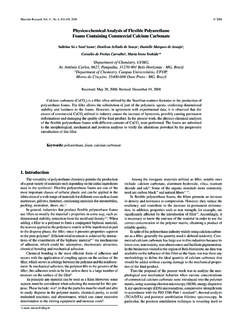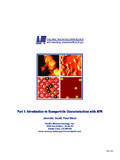Transcription of Co Poplack, Shana. 2001. Code-switching …
1 Struction: Essays in the Honor of Robert Glaser. Erlbaum,Hillsdale, NJDoise W, Mugny G 1984 The Social De!elopment of the Press, OxfordKozulin A 1998 Psychological Sociocultural Approachto ,Cambridge,MAMead G H 1934 Mind,Self,and Society. University of ChicagoPress, ChicagoPauli C, Reusser K 2000 Cultivating students argumentationand reasoning in solving mathematical text problems throughthe use of a computer tool: a video-based analysis Report. University of Zurich Institute ofEducation (http:!! )Perret-Clermont A-N, Perret J-F, Bell N 1991 The socialconstruction of meaning and cognitive activity in elementaryschool children. In: Resnick L B, Levine L, Teasley S D (eds.)Perspecti!es on Socially Shared Cognition. American Psycho-logical Association, Washington, DC pp.
2 41 62 Reusser K 1993 Tutoring systems and pedagogical theory:Representational tools for understanding, planning, andreflection in problem-solving. In: Lajoie S P, Derry S (eds.)Computers as Cogniti!e Tools. Erlbaum, Hillsdale, NJ 78 Roschelle J, Teasley S D 1995 The construction of sharedknowledge in collaborative problem solving. In: O Malley C E(ed.)Computer-supported Collaborati!e ,Berlin pp. 69 97van Oers B 1996 Learning mathematics as meaningful : SteffeLP,NesherP,CobbP,GoldinGA,GreerB(e ds.)Theories of Mathematical Meaning. Erlbaum, Mahwah, NJpp. 91 113 Vygotsky L S 1962 Thought and Language. Harvard UniversityPress, Cambridge, MAWebb N M, Palincsar A S 1996 Group processes in theclassroom. In: Berliner D C, Calfee R C (eds.)Handbook ofEducational , 73K.
3 ReusserCode switching : LinguisticCode- switching (CS) refers to the mixing, by bilinguals(or multilinguals), of two or more languages indiscourse, often with no change of interlocutor ortopic. Such mixing may take place at any level oflinguistic structure, but its occurrence within theconfines of a single sentence, constituent, or even word,has attracted most linguistic attention. This articlesurveys the linguistic treatment of combining languages intrasententially, variousproblems of incompatibility may arise. The mostobvious derive from word order differences: underwhat conditions, if any, can the boundary betweenconstituents ordered differently in two languages hosta switch? Other potential combinatorial difficultiesinvolve mismatches in grammatical categories, sub-categorization patterns, morphology, and idiomaticexpressions.
4 Systematic examination of the sponta-neous speech of bilinguals resident in a wide range ofcommunities suggests, however, that speakers gen-erally manage to circumvent these difficulties. CStends not to produce utterances that contain mono-lingually ungrammatical sentence fragments. Discov-ery of the mechanisms enabling such grammatical CSis the major goal of current research. Central questionsinclude locating permissible switch sites and ascertain-ing the nature (hierarchical or linear, variable orcategorical) of the constraints on BackgroundThough CS is apparently a hallmark of bilingualcommunities world-wide, it has only begun to attractserious scholarly attention in the last few first dismissed intrasentential Code-switching as random and deviant ( , Weinreich1953!)
5 1968) but are now unanimous in the convictionthat it is grammatically constrained. The basis for thisconviction is the empirical observation that bilingualstend to switch intrasententially at certain (morpho)syntactic boundaries and not at others. Early efforts toexplain these preferences proceeded by proscribingcertain switch sites, for example, between pronominalsubjects and verbs or between conjunctions and theirconjuncts. However, these particular sites were soonreported to figure among the regular CS patterns ofsome bilingual first more general account of the distribution ofCS stemmed from the observation that CS is favoredat the kinds of syntactic boundaries which occur inboth languages. Theequi!alence constraint(Poplack1980) states that switched sentences are made up ofconcatenated fragments of alternating languages, eachof which is grammatical in the language of itsprovenance (see also Muysken 2000).
6 The boundarybetween adjacent fragments occurs between two con-stituents that are ordered in the same way in bothlanguages, ensuring the linear coherence of sentencestructure without omitting or duplicating lexical general principles, rather than atomistic con-straints, govern CS is now widely accepted, thoughthere is little consensus as to what they are or how theyshould be represented. Much current research assumesunquestioningly that the mechanisms for languageswitching follow directly from general principles of(monolingual) grammar. Theories based on this as-sumption tend to appeal to such abstract grammaticalproperties as inter-constituent relationships ( , gov-ernment, case assignment) and!or language-specificfeatures of lexical categories ( , subcatgorization ofgrammatical arguments, inherent morphological fea-tures).
7 Since Klavans s (1985) proposal that CS was con-strained by structural relations, the formal linguistictheories successively in vogue have each been extendedto encompass the data of CS. Di Sciullo et al. (1986),for example, identified the relevant relations as C-2062Co-constructi!ism in Educational Theory and Practicecommand and government: CS cannot occur where agovernment relation holds. Replacement of the func-tion of government in standard theory by the notion offeature agreement led to a parallel focus on featurematching in CS studies. TheFunctional Head Con-straint(Belazi et al. 1994) adds language choice to thefeatures instantiated in functional and lexical cate-gories, prohibiting CS where a mismatch occurs. Amore recent Minimalist proposal (MacSwan 1999)restricts CS at structural sites showing cross-languagedifferences in monolingual distinction between lexical and functionalcategories is not new to CS research.
8 It is a hallmark oftheories invoking the complement structure of in-dividual lexical items to characterize permissible CSsites ( , Joshi 1985) and its sequel, theNull Theory ofCS(Santorini and Mahootian 1995; see also Bentahilaand Davies sSubcategorisation Constraint1983). Per-haps the most detailed model involving the contrastbetween lexical properties and functional (or system )morphemes is theMatrix Language Framemodel(Azuma 1993, Myers-Scotton 1993). Here, structuralconstraints on CS result from a complex interactionbetween a dominant matrix language and the pro-hibition against embedding system morphemes fromthe embedded language in matrix language assumption that bilingual syntax can be ex-plained by general principles inferred from the studyof monolingual grammar has not yet been substan-tiated.
9 While formal theories of grammar may accountwell for monolingual language structure, includingthat of the monolingual fragments in CS discourse,there is no evidence to suggest that thejuxtapositionoftwo languages can be explained in the same communities exhibit widely different pat-terns of adapting monolingual resources in theircode-mixing strategies, and these are not predictablethrough purely linguistic considerations. The equi-valence constraint, as formalized by Sankoff(1998), isa production-based explanation of the facts of CS,which incorporates the notions of structural hierarchyand linear order, and accounts for a number ofempirical observations in addition to the equivalentword order characterizing most actual switch include the well-formedness of the monolingualfragments, the conservation of constituent structure,and the essential unpredictability of CS at any poten-tial CS site.
10 The mechanisms of monolingual andbilingual grammars are not assumeda priorito E!aluating CS TheoriesThere has been remarkably little cross-fertilizationamong CS theories; indeed, each has been greeted witha host of counter-examples. Testing the fit of com-peting models against the data of CS should be astraightforward matter since they often make com-peting predictions. But their disparate assumptions,goals, and domains of application have hindered suchefforts. Assessment of the descriptive adequacy of atheory of CS requires that at least two methodologicalissues be resolved. One involves classification of other-language phenomena, the other, confronting the pre-dictions of the theory with the data of actual is uncontroversial that CS differs from the othermajor manifestation of language contact:lexical bor-rowing.







